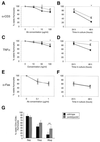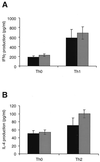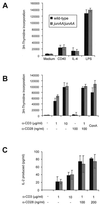Jun N-terminal kinase 2 modulates thymocyte apoptosis and T cell activation through c-Jun and nuclear factor of activated T cell (NF-AT)
- PMID: 11172026
- PMCID: PMC29332
- DOI: 10.1073/pnas.98.4.1769
Jun N-terminal kinase 2 modulates thymocyte apoptosis and T cell activation through c-Jun and nuclear factor of activated T cell (NF-AT)
Abstract
The Jun N-terminal kinases (JNKs) recently have been shown to be required for thymocyte apoptosis and T cell differentiation and/or proliferation. To investigate the molecular targets of JNK signaling in lymphoid cells, we used mice in which the serines phosphorylated by JNK in c-Jun were replaced by homologous recombination with alanines (junAA mice). Lymphocytes from these mice showed no phosphorylation of c-Jun in response to activation stimuli, whereas c-Jun was rapidly phosphorylated in wild-type cells. Despite the fact that c-jun is essential for early development, junAA mice develop normally; however, c-Jun N-terminal phosphorylation was required for efficient T cell receptor-induced and tumor necrosis factor-alpha-induced thymocyte apoptosis. In contrast, c-Jun phosphorylation by JNK is not required for T cell proliferation or differentiation. Because jnk2-/- T cells display a proliferation defect, we concluded that JNK2 must have other substrates required for lymphocyte function. Surprisingly, jnk2-/- T cells showed reduced NF-AT DNA-binding activity after activation. Furthermore, overexpression of JNK2 in Jurkat T cells strongly enhanced NF-AT-dependent transcription. These results demonstrate that JNK signaling differentially uses c-Jun and NF-AT as molecular effectors during thymocyte apoptosis and T cell proliferation.
Figures





References
-
- Whitmarsh A J, Davis R J. J Mol Med. 1996;74:589–607. - PubMed
-
- Dong C, Yang D D, Wysk M, Whitmarsh A J, Davis R J, Flavell R A. Science. 1998;282:2092–2095. - PubMed
-
- Sabapathy K, Hu Y, Kallunki T, Schreiber M, David J P, Jochum W, Wagner E F, Karin M. Curr Biol. 1999;9:116–125. - PubMed
-
- Yang D D, Conze D, Whitmarsh A J, Barrett T, Davis R J, Rincon M, Flavell R A. Immunity. 1998;9:575–585. - PubMed
Publication types
MeSH terms
Substances
LinkOut - more resources
Full Text Sources
Other Literature Sources
Molecular Biology Databases
Research Materials
Miscellaneous

